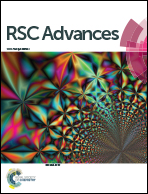Facile synthesis and enhanced visible-light photocatalytic activity of graphitic carbon nitride decorated with ultrafine Fe2O3 nanoparticles†
Abstract
Hybrid nanocomposites based on graphitic carbon nitride (g-C3N4) nanosheet supported ultrafine Fe2O3 nanoparticles have been successfully prepared by a facile thermal polymerization and deposition-precipitation method. Characterization results demonstrate that Fe2O3/g-C3N4 nanocomposites exhibit a well-defined morphology, in which Fe2O3 nanocrystals of 3 nm size with a narrow particle distribution are uniformly dispersed on the layers of the g-C3N4 nanosheets. Photocatalytic reaction results indicate that the photocatalytic activity of g-C3N4 is significantly enhanced after introduction of a small amount of Fe2O3, and the optimum activity of the Fe2O3/g-C3N4 nanocomposites with a weight ratio of Fe2O3 at 0.1% is up to about 3 times and 62 times higher than those of pure g-C3N4 and pure Fe2O3, respectively, for the degradation of organic dye Rhodamine B (RhB) under visible light irradiation. The high performance of the Fe2O3/g-C3N4 photocatalysts is mainly attributed to the synergistic effect at the interface of the heterojunction between Fe2O3 nanoparticles and g-C3N4 nanosheets, including improved separation efficiency of the charge carriers, a suppressed recombination process and suitable band position of the composites. These results underline the potential for the development of effective, low-cost and earth-abundant photocatalysts for the promotion of water splitting and environmental remediation under natural sunlight by construction of sustainable g-C3N4 polymeric materials.



 Please wait while we load your content...
Please wait while we load your content...